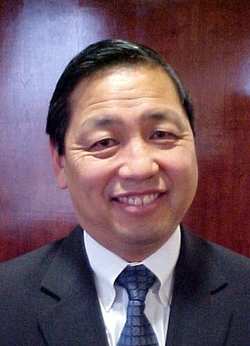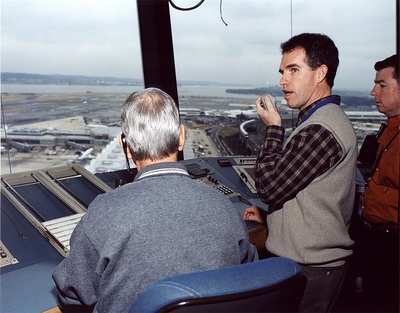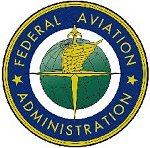Says Current Equipment Cannot Handle Projected Traffic
Increase
 Editor's Note:
In a speech titled "Congested Skies" before the International Civil
Aviation Organization (ICAO) Conference in Montreal September 28,
FAA Air Traffic Organization Chairman Russell Chew (right) made his
pitch for expanded capability and new equipment for controllers,
that he says are needed to handle the projected growth in air
traffic by 2014. He also highlighted the partnership between the
FAA and Europe, with its SESAR project -- and called for expanded
cooperation there, as well. ANN presents the entire speech,
unedited, below.
Editor's Note:
In a speech titled "Congested Skies" before the International Civil
Aviation Organization (ICAO) Conference in Montreal September 28,
FAA Air Traffic Organization Chairman Russell Chew (right) made his
pitch for expanded capability and new equipment for controllers,
that he says are needed to handle the projected growth in air
traffic by 2014. He also highlighted the partnership between the
FAA and Europe, with its SESAR project -- and called for expanded
cooperation there, as well. ANN presents the entire speech,
unedited, below.
Good morning, I’m honored to be here with Carol and Victor
to kick things off in the opening panel of the conference. But
before I begin, have you ever wondered where this phrase, "Kick
things off" came from?
It comes from the opening kickoff that started a football game
-- we call it soccer -- when the game was being developed in
England in the mid 1800s. Back then, there were many different
football clubs -- each playing by their own set of rules. This, of
course, made competition with other clubs difficult. But in 1878,
the various clubs united in what was known as the Football
Association.
In the Football Association, the different clubs were able to
harmonize -- so that an official set of rules could be created.
These rules led to the games’ innovation, and guided its
evolution. A hundred and thirty years later, the Football
Association still endures, as part of FIFA, the sponsor of the
World Cup Tournament.
Now, what does this have to do with us? Well, we’re here
to do the same thing — come together to discuss the important
issues in aviation. At this conference, we’ll discuss how to
shape the policies and rules that will determine aviation’s
future — and advance the process of finding innovative
solutions to these issues.
One major issue coming onto the world’s radar screen is
the social and economic threat posed by increased air traffic
congestion — a threat brought on by a projected surge in
passenger growth in the near future.
Consider the evidence. By 2016, the FAA projects that domestic
flights in the U.S. will increase by 27 percent over 2005 levels
— that’s over one quarter of our current total.
Passenger traffic between the U.S. and international destinations
is expected to grow by 70 percent, and world-wide traffic is
projected to increase by as much as 80 percent.
While the pace of this growth is exciting, it brings with it the
challenge of congestion. Congestion steals time away from being
with family and friends, limits our freedom and enjoyment as
travelers, and it’s an increasing drag on the global economy.
In fact, today’s tab for the American people stands at $9.4
billion a year due to commercial passenger delays — and that
number could climb as high as $20 billion by 2025.
We also project that if traffic grows as expected, by 2014,
delays in the US will increase 62 percent over 2004 levels.
And if the weather in 2014 is the same as it was in 2004, 29
days in 2014 will experience more delay than on the worst day in
2004. That’s a whole month!
These projected delays will cost the airlines at least $2
billion in extra costs that will seriously erode profits needed for
future fleet and infrastructure expansions.
And, the situation is even worse for passengers. Because of
missed connections, passenger delays could conceivably double by
2014 — only seven years from now.
In light of this increasing threat, we must build sufficient
capacity so that congestion does not deprive us of the benefits
that aviation brings.
However, what’s more important than reducing delays, is
the safety of our system. That’s our highest priority. And
congestion poses a major challenge here too.

We know from our data that operational errors often occur when
traffic levels are lower. But our recent research has shown that
they occur more often in our facilities that handle heavier traffic
volume.
We’ve also been doing some new research that tested a
controller’s ability to handle increases in traffic. Early
results suggest that when using our current technology, the
controllers could not handle the increased volume of traffic
without significantly degrading the level of service that our
customers expect.
But when controllers had the right kind of automation, one that
uses new and integrated technology, they were able to handle the
traffic while maintaining a very reasonable level of workload, and
this reduces the opportunities for human error.
Now, while these research programs help us define the path
forward, our automation has historically been designed using humans
as a "back up." We need technology with more redundancy. In other
words -- we need technology that cannot fail.
 Now, to ensure that our
technology development and research is pointed in the right
direction, we’re also focused on our work culture in the Air
Traffic Organization. We are reinventing ourselves into a
performance-based organization. We focus on producing greater value
for our customers by developing a strategy that is based on
measurable outcome, and we use that strategy to drive all our
priorities. This is a culture where all employees at all levels are
encouraged to take the initiative in helping us solve our growing
congestion problems. This is the kind of culture that we need to
succeed.
Now, to ensure that our
technology development and research is pointed in the right
direction, we’re also focused on our work culture in the Air
Traffic Organization. We are reinventing ourselves into a
performance-based organization. We focus on producing greater value
for our customers by developing a strategy that is based on
measurable outcome, and we use that strategy to drive all our
priorities. This is a culture where all employees at all levels are
encouraged to take the initiative in helping us solve our growing
congestion problems. This is the kind of culture that we need to
succeed.
All of these efforts are critical stepping stones that will
bring us to the Next Generation Air Transportation System.
It’s a system-wide transformation that will allow us to
handle two to three times the current amount of traffic, and a
system that’s flexible enough to manage the new and different
types of vehicles that the market may bring in the next 20
years.
Europe is, of course, pursuing the Single European Sky Air
Traffic Management Research program, or SESAR. We must continue to
work in partnership together, and harmonize our operations, so that
we can all reap the benefits of a vibrant, accessible, global
aviation system.
Aviation is the foundation for globalization. It’s the
glue that binds together our people, our cultures, our economies,
and our futures. Its transformation, by definition, will challenge
the rules and policies that our existing system is based on.
So at this conference, let’s discuss what works, and what
doesn’t. And let’s "kick off" the start of, not just a
conference, but also a united vision that takes us to the Next
Generation of flight. Thank you.
 Classic Aero-TV: The Switchblade Flying Car FLIES!
Classic Aero-TV: The Switchblade Flying Car FLIES! ANN FAQ: Q&A 101
ANN FAQ: Q&A 101 ANN's Daily Aero-Term (04.12.24): Discrete Code
ANN's Daily Aero-Term (04.12.24): Discrete Code ANN's Daily Aero-Term (04.13.24): Beyond Visual Line Of Sight (BVLOS)
ANN's Daily Aero-Term (04.13.24): Beyond Visual Line Of Sight (BVLOS) ANN's Daily Aero-Linx (04.13.24)
ANN's Daily Aero-Linx (04.13.24)





